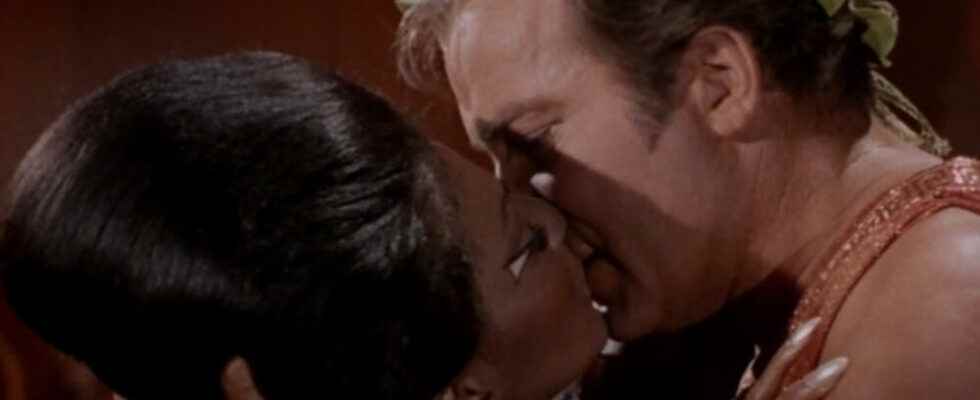It’s not a particularly good episode, but it does include Plato’s stepchildren from Starship Enterprise Season 3 one of the most important Star Trek scenes at all. In it, Captain Kirk takes Lieutenant Uhura in his arms. They kiss and that’s it. In the USA of the 1960s, which was characterized by racist discrimination, it was by no means a matter of course for a white man to kiss a black woman in front of the camera.
After Uhura actress Nichelle Nichols passed away on Sunday at the age of 89, we look back at the making of the scene, in which she and colleague William Shatner had to resort to unusual means.
The kiss only made it into the Star Trek episode thanks to sabotage
Towards the end of the 1968 Star Trek episode, Kirk and Uhura are under the telekinetic control of what are known as the Platonists. These force the two Starfleet officers to kiss. That’s what Meyer Dolinsky said in the screenplay.
© Paramount
The most famous Star Trek kiss
The prospect of one Kiss between a white man and a black woman made the broadcaster NBC nervous. What if TV stations in the US South refused to air the episode? Sexual relations between white and black people were a taboo subject.
So NBC looked for all sorts of ways not to alienate the racists. So the suggestion was made that the Vulcan Spock (Leonardo Nimoy) should kiss Uhura, but according to Nichelle Nichols, William Shatner insisted on filming the scene himself.
So the stars sabotaged the shoot
In her biography Beyond Uhura, the actress described how the next attempt at censorship was foiled: the Star Trek crew was supposed to two versions of the scene turn, once with a kiss and once without. After the kissing scene was wrapped, the two stars did their best to screw up the kissless version. Then NBC would be forced to show the first version. Nichols writes:
Aware that [Star Trek-Schöpfer Gene Roddenberry] really wanted to show the real kiss, Bill has [Shatner] shook me and hissed menacingly in his best exaggerated Kirk emphasis: I! Will! You! Not! Kiss! I! Will! You! Not! Kiss!
“It was absolutely awful and we had a lot of fun and were thrilled”, the Star Trek legend wrote in her book. When the footage was shown to the crew the next day, everyone burst out laughing. In the last shot of the kiss-free scene, Shatner even squinted. Nicholas on this:
It was so cheesy and just plain badthat it was useless. The only alternative was to cut out the scene entirely, but that was impossible without ruining the whole episode.
So there was no other way but to finish the episode with the kissing scene that would go down in TV history.
Why the scene is so important
With hindsight, the moment has often been described as the first “interracial” kiss in US television history, which remains controversial to this day. The episode caused little excitement when it was broadcast, and Nichols also wrote that she received mostly positive fan mail.
Even so, one should consider the symbolic meaning of the kiss do not underestimate. In the American South, racial segregation had only been abolished four years before the episode aired. And it wasn’t until 1967, a year before production, that the US Supreme Court ruled that bans on “interracial” marriages were unconstitutional.
Of the Kiss from Kirk and Uhura aired during a much-needed turning point in civil rights and equality. He symbolized a new normal, including in popular culture. In the long run, the image of Kirk and Uhura also outshined the context of the episode. The kiss in the episode was forced, but it went down in television history as a symbol of freedom.
